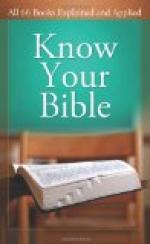I. Creation, Chs. 1-2.
1. Creation in general, Ch. 1.
2. Creation of man in particular, Ch. 2.
II. Fall. Ch. 3.
1 Temptation, 1-5.
2. Fall, 6-8.
3. Lord’s appearance, 9-13.
4. Curse, 14-21. 5. Exclusion from the garden, 22-24.
III. Flood, Chs. 4-9.
1. Growth of sin through Cain, 4:1-24.
2. Genealogy of Noah, 4: 25-5 end,
3. Building of the Ark, Ch. 6.
4. Occupying the Ark, Ch. 7.
5. Departure from the Ark, Ch. 8.
6. Covenant with Noah, Ch. 9.
IV. Nations, 10:1-11:9.
1. Basis of Nations, Noah’s sons, Ch. 10. How?
2. Occasion of forming the nations, 11:1-9. Why?
V. Abraham, 11:10-25:18.
1. Genealogy of Abram from Shem, 11:10 end.
2. Call and promise, Ch. 12.
3. Abraham and Lot, Chs. 13-14.
4. Covenant, 15: 1-18: 15.
5. Destruction of Sodom and Gomorrah, 18:16-19 end.
6. Lives at Gerar, Ch. 20.
7. Birth of Isaac, Ch. 21.
8. Sacrifice of Isaac, Ch. 22.
9. Death of Sarah, Ch. 23.
10. Marriage of Isaac, Ch. 24.
11. Death of Abraham and Ishmael, 25:1-18.
VI. Isaac. 26:19-36 end.
1. His two sons, 25:19 end.
2. Divine covenant. Ch. 26.
3. Jacob’s deception, Ch. 27.
4. Jacob’s flight into Haran, Ch. 28.
5. Jacob’s marriage and prosperity, Chs. 20-30.
6. Jacob’s return to Canaan. Chs, 31-35.
7. Generations of Esau, Ch. 36.
VII. Jacob, including Joseph, Chs. 37-50.
1. Jacob and Joseph, Chs. 37-45.
2. Sojourn in Egypt, Chs. 46-48.
3. Death of Jacob and Joseph, Chs. 49-50. For Study and Discussion. (1) All that we may learn from this book concerning the nature and work of God. (2) The different things the origin of which this book tells: (a) Inanimate things, (b) Plant life, (c) Animal life, (d) Human life, (e) Devices for comfort and safety, (f) Sin and its varied effects, (g) Various trades and manners of life, (h) Redemption, (i) Condemnation. (3) Worship as it appears in Genesis, its form and development. (4) The principal men of the book and the elements of weakness and strength in the character of each. The teacher may make a list and assign them for study to different pupils. (5) List the disappointments, family troubles and sorrows of Jacob, and study them in the light of his early deception and fraud. (6) The over-ruling divine providence seen in the career of Joseph, with the present day lessons from the incidents of his life. (7) The fundamental value of faith in the life and destiny of men. (8) The Messianic promises, types and symbols of the entire book. List and classify them.




